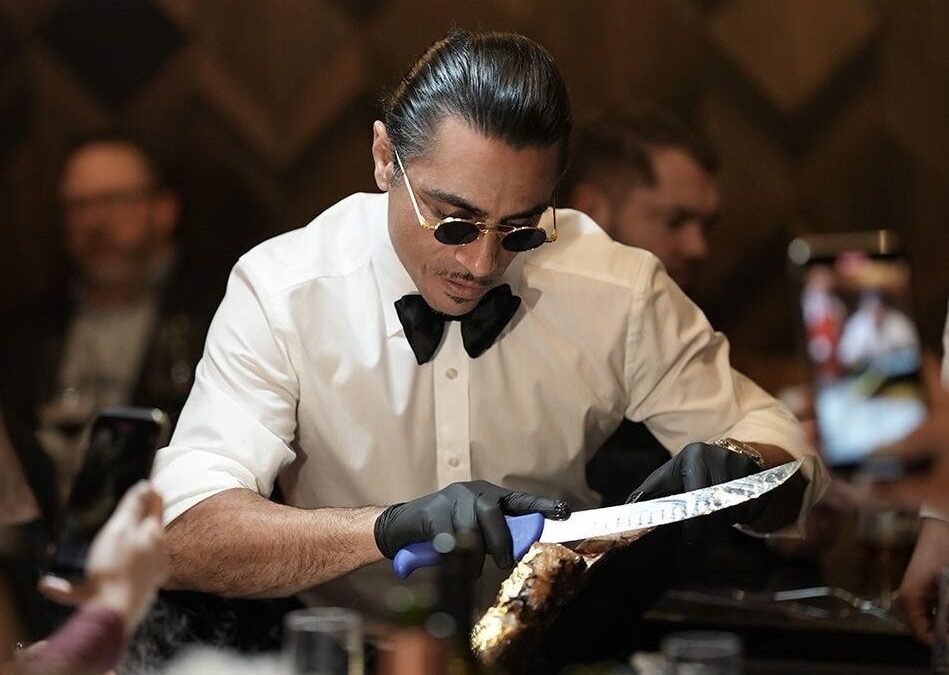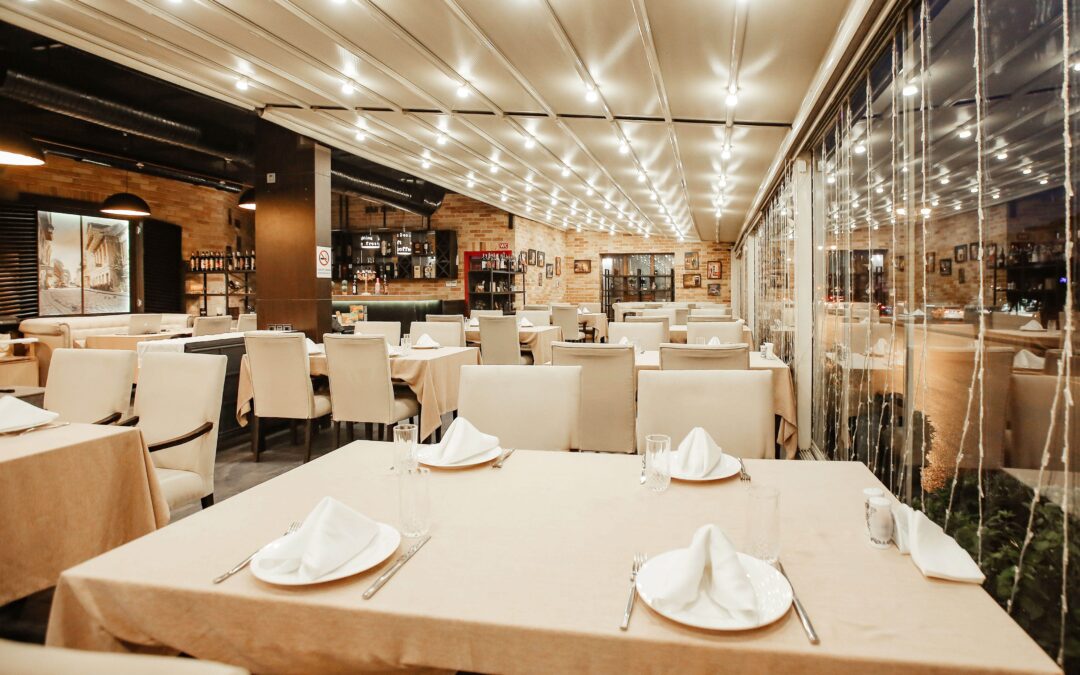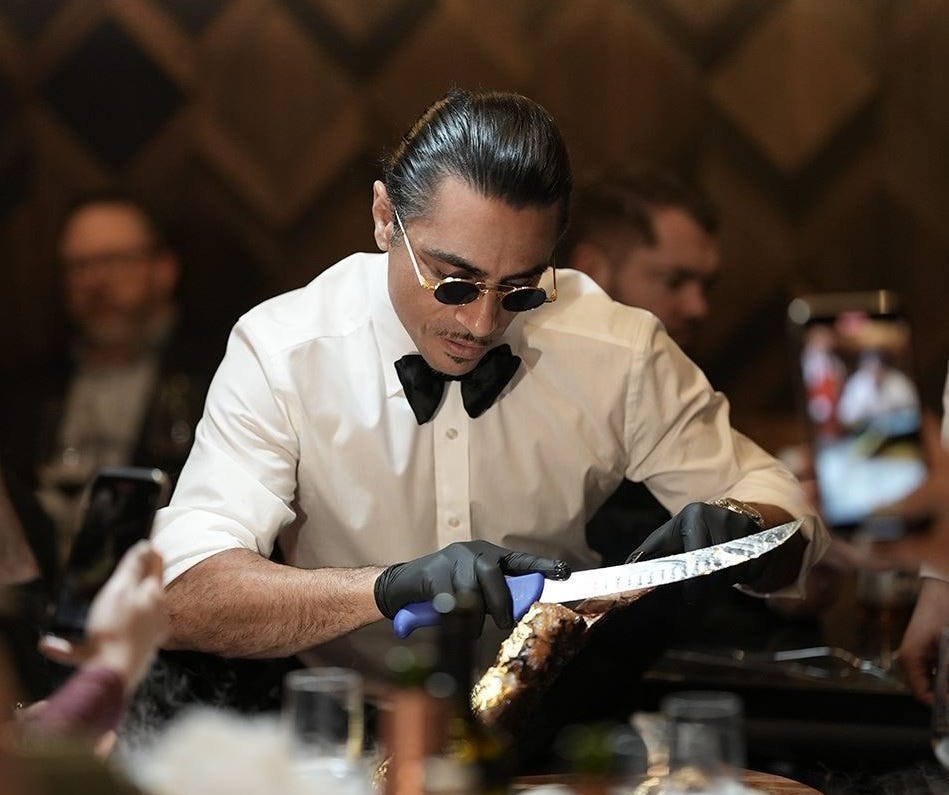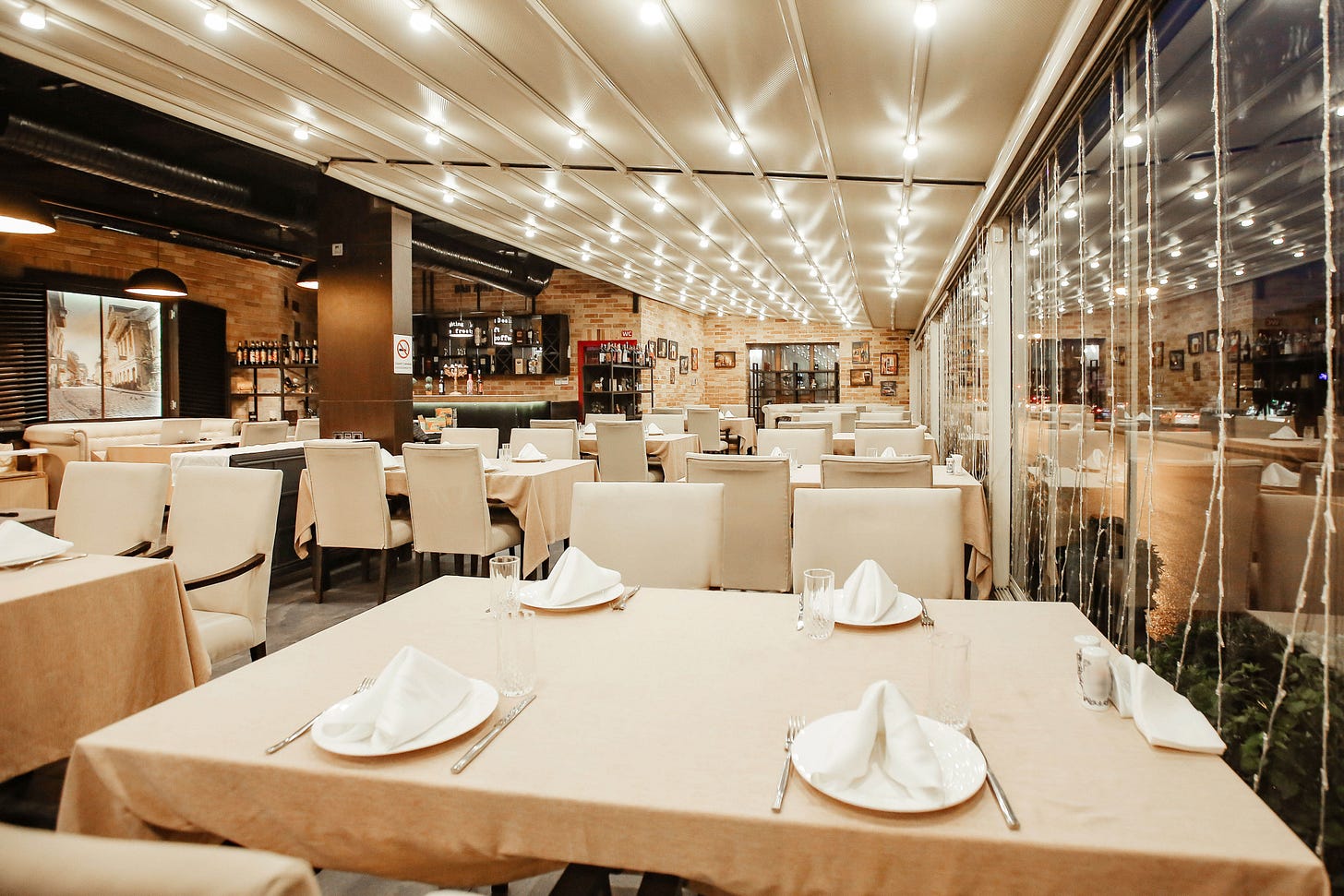
by lspeed | Oct 22, 2025 | BLACK BOX: RANTS, RAVES, REVIEWS & RECIPES
I’ve watched the rise of Salt Bae (Nusret Gökçe) with a mix of fascination, curiosity, and professional sympathy. Anyone who runs a serious steakhouse like us can grasp what it takes to go from carving meat behind a counter to building and presiding over a global restaurant brand. And yet, what we’re seeing now with the Nusr-Et empire is a reminder that in this business, fame can feed you – at least for a while. But consistency is what keeps the doors open when the spotlight fades.
From Butcher’s Block to Fame
Nusret’s story starts humbly. Born in eastern Turkey in 1983, he left school early, apprenticed with butchers in Istanbul, and worked his way up. Hands-on, old-school, knife-in-hand, the hard way. In 2010, he opened the first Nusr-Et Steakhouse in Istanbul’s Etiler district. By all accounts, it was good. The meat was well-sourced, and the showmanship added charm. He had that rare combination of precision, presence, and a bit of theater that diners remembered.
Then came that video in 2017. The salt-sprinkling gesture that went viral and turned a hard-working butcher into an internet celebrity overnight. It was show business meets steakhouse, and for a while, the whole world wanted to dine at his table. Every restaurant owner I know watched that clip thinking, “Good for him.” Because we all dream of that lightning-in-a-bottle moment when your craft suddenly connects with the public imagination.
The Power Trap of Hype
Viral fame can do what decades of PR cannot. Overnight, “Salt Bae” became a brand. Celebrities posted selfies, influencers queued for a photo, and the media coverage was relentless. Within a few years, Nusr-Et went from one Istanbul location to a global chain with branches in Dubai, Doha, Miami, New York, London, and Beverly Hills.
The concept was simple: steak as spectacle. Theatrics, gold-leaf tomahawks, thumping music, and servers trained to perform the signature flourish. Guests didn’t just dine, they documented it. That’s powerful marketing. But there’s a catch – when your brand is built on performance, you need to deliver a show every night. And when you expand that show to dozens of countries, you’re no longer running kitchens, you’re running a stage production.
Behind the Curtain
In recent years, reports surfaced that the empire isn’t as smooth as it looks online. Multiple ex-employees have filed lawsuits or made claims about unpaid wages, withheld tips, and aggressive management culture. Some mentioned favoritism or discrimination by nationality. Others described the work environment as “toxic,” where staff were praised one day and dismissed the next.
Now, I’m not here to pass judgment. Every large hospitality group faces HR headaches. When you scale fast, especially across borders, things are bound to get complex very quickly. Labour laws differ. Training standards slip. Managers cut corners. Still, the pattern of claims suggests deeper cracks between the brand image and daily operations. As a restaurateur I can say this – hype magnifies both the glory and the growing pains. When people line up to film your restaurant, you’re not just serving food anymore, you’re performing under a microscope.
Downsized Dreams
That microscope got sharper when closures began. As of 2025, several Nusr-Et locations in the U.S. shut down. The Beverly Hills branch, arguably the crown jewel, closed suddenly last June. Earlier, the “Salt Bae Burger” spin-off in New York had folded after poor reviews. Across the Atlantic, the London Knightsbridge flagship, once pulling in over £13 million annually, saw revenue drop to £9 million, with profits sliding as costs rose. Reports say management cut heating, dimmed lights during quiet hours, and removed the gold-coated steaks from the menu to save on costs.
Those of us in the trade recognize the signs – a brand under pressure, trimming fat to stay afloat. Inflation, energy prices, rising rents, it hits all of us. But when your concept revolves around spectacle and luxury, you can’t quietly “go lean” without losing the magic.
Show Versus Substance
The real issue isn’t just costs, it’s the business model. The Salt Bae brand sold exclusivity, luxury, indulgence. But that fantasy depends on endless novelty. When people stop posting, the buzz fades, and the gold leaf starts to look a little tacky instead of glamorous. In my own experience, diners eventually come back to what matters – flavor, consistency, and connection.
You can’t salt-pose your way through a bad cut of beef or a stressed-out team. Nusret’s instinct for showmanship is rare. He understood early on that diners wanted emotion with their meal, not just protein. But emotional connection needs authenticity behind it. Without that, what’s left is a nightly performance that fades over time, just as a long running broadway show does.
A Brand Under Pressure
Despite the closures, it’s too early to write the obituary. The Nusr-Et brand is still on display in Turkey, Dubai, and Qatar. These markets appreciate luxury dining, and Salt Bae remains a recognizable figure with millions of followers. The group seems to be consolidating by closing underperforming sites, tightening operations, and focusing on markets that still resonate with the brand’s original formula. Some locations remain profitable, and there’s clearly a loyal clientele who see Nusr-Et as a special-occasion splurge.
The Lesson for the Rest of Us
From one steakhouse owner to another, I see in Salt Bae’s story a parable of our times, meaning the triumph and the trap of viral fame. It shows how the internet can build a global dining empire, and how quickly that same glare can expose its cracks. The restaurant business has always balanced artistry with arithmetic. You can’t feed the spreadsheet without feeding people’s senses, and you can’t stay inspired if you’re just chasing margins.
Nusr-Et’s early years struck that balance beautifully. But somewhere along the way, the numbers and the cameras started calling the shots. Maybe this is the natural cycle. Every trend burns bright, then settles into something steadier. The real test will be whether the brand can evolve and move from being a meme to being a mature institution.
That means less focus on gold tomahawks and more on what first made it special – consistency and hospitality that feels human. I hope Nusret Gökçe finds a way to turn the spotlight into a steady flame. Because beneath the memes and the theatrics is a man who once just wanted to serve a perfect piece of meat. And that, in our business, is still the only real magic that lasts.
Image Credit: https://www.nusr-et.com.tr/Resources/GalleryImage/
_ _ _
© CHURRASCO PHUKET STEAKHOUSE / ALL RIGHTS RESERVED
Reprinting, reposting & sharing allowed, in exchange for a backlink and credits
Churrasco Phuket Steakhouse serves affordable Wagyu and Black Angus steaks and burgers. We are open daily from 12noon to 11pm at Jungceylon Shopping Center in Patong / Phuket.
We are family-friendly and offer free parking and Wi-Fi for guests. See our menus, reserve your table, find our location, and check all guest reviews here:
https://ChurrascoPhuket.com/
#Churrascophuket #jungceylon #phuketsteakhouse #affordablewagyu #wagyu

by lspeed | Oct 8, 2025 | BLACK BOX: RANTS, RAVES, REVIEWS & RECIPES
On certain nights, running a steakhouse is like hosting a wedding where every guest is the bride, every steak is the bouquet, and the kitchen is the band that keeps getting asked to change the song mid chorus. We have spent years perfecting how to coax flavor from fire, how to turn a piece of raw beef into something people photograph before they eat and never forget, and how to smile politely when someone orders filet mignon well done with a glass of soda water and a side of Tabasco mayo.
Our job is to make your dinner great and to have you leave happy. But once in a while, just as your server turns to head back to the kitchen, guests say something that stops us in our tracks. Something that makes the grill cook stare into the flame a little longer than necessary. Something that signals this meal might be heading for what we like to call a slow and avoidable compromise.
What follows is not a rulebook and not actually a proper rant. It is a short and useful guide to a few phrases we hear far too often. Phrases that almost always lead to regret, confusion, or an underwhelming bite of beef. Here are our top hits:
“Can I get it medium plus”
We hear this one a lot, and every time, we have the same reaction. Medium plus is not a thing. There is no secret setting between medium and medium well that only certain restaurants know about. It is not a doneness level. It is a feeling, and feelings are hard to grill. What usually happens is that we cook your steak just past medium, land it somewhere around medium well, and hope for the best. But we would much rather just talk about what you actually want. If you want less pink but still want it to be tender, we can do that. Just tell us. We promise we will not make you say it in Latin or use technical terms. Just describe what you are after, and we will take care of the rest.
“What steak is trending right now”
This one always feels like someone is asking for the limited edition sneaker version of beef. Steak does not trend. There is no seasonal launch. Cuts do not go in and out of fashion like handbags or soft drinks. If you saw something specific on social media and want to ask if we have it, by all means do. But do not expect steak to follow a hype cycle. We are not here to reinvent the ribeye every three months. We serve the classics because they are good. Because they work. Because nothing beats a properly seared sirloin or a marbled ribeye with just enough fat to remind you why you came here in the first place.
“I have the filet, but can I make changes?”
This is usually said in the tone of someone who believes they are being very reasonable. But what sounds like a few harmless swaps often results in a kitchen trying to build a dish that no longer makes sense. We will always do what we can. Allergies, of course. Sensitivities, absolutely. But once you start removing ingredients, changing sauces, adjusting cooking techniques, and adding substitutions, the dish is no longer what we designed. And while we will cook it, it will likely not be something we feel great about serving. If there is something specific you are avoiding, just say so. But if it is more about trying to improve a dish that is already balanced, maybe try ordering it the way it was meant to be served. You might be pleasantly surprised.
“Can you make it quick”
This one usually comes with a smile and a glance at a phone screen showing a countdown to a concert or airport check in. And while we understand that everyone is busy, we feel obligated to point out that steak does not respect your schedule. It takes time to cook a steak properly. It takes more time to rest it properly. And while we can absolutely suggest something faster, asking us to hurry the cooking process is like asking a baker to rush a soufflé. You can do it, but you will not like what comes out. If you are in a rush, just tell us. We can help. But please do not ask us to shortcut something that needs time to be good.
“I do not drink white wine with steak”
That is fine. But you should know that it is not a rule. It never was. Red wine goes beautifully with beef. Everyone knows that. But there are plenty of white wines that can hold their own. A full bodied white with oak and acidity can cut through a rich sauce. A mature white Rioja or Sémillon can bring out flavors in aged beef that most reds never touch. And if you have never had Champagne with a pepper crusted tenderloin, then you are missing out on something strange and wonderful. We are not saying you should switch teams. But if you usually drink white, do not let old habits talk you out of it. Let us help you find a pairing that works. That is what we are here for.
So Please – Let Us Do What We Do
We are not here to turn steak into a sacred ritual with rules and penalties. We are here to serve a meal that feels worth it. A dinner that reminds you why people still go out to dinner. A meal you might actually remember the next day.
It is because we care about the outcome. That is why you are here and why we still love this business. Even when someone orders a wagyu ribeye well done and asks for banana ketchup on the side. We’ll make sure it’s coming right up …
Image Credit: https://freepik.com
_ _ _
© CHURRASCO PHUKET STEAKHOUSE / ALL RIGHTS RESERVED
Reprinting, reposting & sharing allowed, in exchange for a backlink and credits
Churrasco Phuket Steakhouse serves affordable Wagyu and Black Angus steaks and burgers. We are open daily from 12noon to 11pm at Jungceylon Shopping Center in Patong / Phuket.
We are family-friendly and offer free parking and Wi-Fi for guests. See our menus, reserve your table, find our location, and check all guest reviews here:
https://ChurrascoPhuket.com/
#Churrascophuket #jungceylon #phuketsteakhouse #affordablewagyu #wagyu

by lspeed | Oct 5, 2025 | BLACK BOX: RANTS, RAVES, REVIEWS & RECIPES
Headlines proclaim that Generation Z, the cohort born between the mid-1990s and early 2010s, is drinking far less than those who came before them. Market analysts, health commentators, and beverage companies themselves have embraced the label of a “sober generation.” But as more data comes in, the story looks less like a tale of permanent abstinence and more like one of evolution and context.
The Decline
The case for Gen-Z drinking less rests on some strong numbers. According to a recent Morgan Stanley report, Gen-Z consumes about 30 percent less alcohol than Millennials did at the same age. In the U.S., average weekly drinks among 18-34 year-olds have dropped from 5.2 to 3.6 over the past two decades.
This decline is not limited to young people. Spirits sales fell by 8 percent in a single four-week period this year, while beer volumes are down more than 5 percent year-on-year. Even the once-reliable 35–54 age bracket, long considered the backbone of the alcohol industry, has plateaued after two decades of steady growth.
At the same time, alternatives are thriving. Non-alcoholic and functional beverages are booming: Coke Zero and Monster Energy continue to record strong volume growth, and in Western Europe, no- and low-alcohol beer now holds more than 5 percent of market share. These developments suggest something bigger than a generational quirk—they point toward a structural shift in how consumers view alcohol.
The Context
But here is where the narrative becomes more complicated. Surveys conducted by IWSR’s Bevtrac project paint a different picture of Gen-Z’s habits over the past two years. Across 15 major markets, the share of legal-age Gen-Z consumers who had consumed alcohol in the past six months rose from 66 percent in March 2023 to 73 percent in March 2025.
The gains are particularly striking in countries like the U.S., where the figure jumped from 46 to 70 percent, and Australia, which rose from 61 to 83 percent. So which is it? Are Gen-Zers cutting back, or are they drinking more? The answer lies in understanding both the timing and the context.
Moderation Or Abstinence?
Richard Halstead, COO of Consumer Insights at IWSR, argues that moderation, not abstinence, is the better story. Alcohol consumption has always tracked closely with disposable income. Gen-Z came of age during a cost-of-living crisis: high rent, inflation, and steep price hikes at bars and restaurants hit just as they entered legal drinking age. It is little wonder their initial drinking levels looked lower compared to older cohorts at the same life stage.
As more Gen-Zer’s enter the workforce and achieve financial stability, their consumption levels are climbing. But this does not mean they are returning to the binge-drinking culture once associated with youth. Instead, they are showing a clear preference for intentional drinking: fewer occasions, smaller volumes, and higher-quality products.
The Intentional Generation
Gen-Z’s approach can best be summed up in the word “refinement”. Rather than rejecting alcohol altogether, they are curating their experiences. Craft cocktails, premium spirits, and beverages with strong brand stories or wellness credentials appeal to them more than cheap quantity. This shift reflects wider cultural values. Wellness culture, social media, and a greater awareness of mental health all feed into choices about drinking. A beautifully mixed cocktail or a niche craft beer offers an experience that fits their identity, while a night of excess does not. In this way, Gen-Z is not killing alcohol culture as such. They are reshaping it around intentionality, aesthetics, and meaning.
Industry Implications
For alcohol brands, this duality of less overall volume but renewed interest in quality and experience, poses both challenges and opportunities. The old model of relying on younger generations to “catch up” to the drinking patterns of their elders no longer applies in the same way.
Producers must now cater to two simultaneous demands: moderation and premiumization. That means investing in no- and low-alcohol products while also elevating the experiences around traditional drinks. Storytelling, craftsmanship, and lifestyle alignment matter more than mass-market volume pushes.
Investors have already noticed the pressure. Alcohol stocks like Brown-Forman and Boston Beer are trading well below yearly highs, reflecting doubts about future growth. Yet the rise of functional drinks and the premium segment suggests that value, not volume, will determine the winners in the years ahead.
Understanding Contradictions
The apparent contradiction of decline on one hand, rebound on the other, make sense when seen together. Yes, the statistics confirm that overall alcohol use has declined compared to past decades. But they also show that Gen-Z is not abandoning alcohol entirely. Instead, they are rewriting the rules of engagement, with moderation and meaning at the center.
Image Credit: https://freepik.com
_ _ _
© CHURRASCO PHUKET STEAKHOUSE / ALL RIGHTS RESERVED
Reprinting, reposting & sharing allowed, in exchange for a backlink and credits
Churrasco Phuket Steakhouse serves affordable Wagyu and Black Angus steaks and burgers. We are open daily from 12noon to 11pm at Jungceylon Shopping Center in Patong / Phuket.
We are family-friendly and offer free parking and Wi-Fi for guests. See our menus, reserve your table, find our location, and check all guest reviews here:
https://ChurrascoPhuket.com/
#Churrascophuket #jungceylon #phuketsteakhouse #affordablewagyu #wagyu

by lspeed | Sep 21, 2025 | BLACK BOX: RANTS, RAVES, REVIEWS & RECIPES
The paradox of restaurants is that excellence gives you a chance to succeed, but never a guarantee. What can separate the survivors from the fallen is not just flawless execution, but whether they managed to capture and hold onto that unexplainable spark that makes a restaurant feel like more than just another place to eat. Failure is explained away by poor execution, bad food, or weak service. But there’s a more painful reality that seasoned operators know well. Sometimes, restaurants fail even when they’ve seemingly done everything right.
Fragile Location
Even with the best menu and service, the wrong location can slowly bleed a restaurant dry. A prime street corner can suddenly become a dead zone if traffic patterns change, nearby construction drags on for years, or a major anchor tenant leaves a shopping complex. Unlike retail chains that can absorb losses across multiple outlets, a single independent restaurant is fully exposed to these shifts. Sometimes, a street or district simply “goes cold,” and no amount of culinary excellence can compensate.
Cost Spiral
Restaurants in high-cost locations operate on notoriously thin margins, often between 3–5 percent. Even when the dining room is full and online reviews glow, one unexpected increase can throw off the balance. A landlord raising rent by 20 percent, a sudden rise in minimum wages, or surging electricity prices can tip the equation into unsustainability. Operators who have perfected their operations are not immune to structural cost increases, they simply have less room to maneuver.
Shifts in Consumer Behavior
Dining trends evolve quickly, sometimes brutally. A restaurant may have captured the zeitgeist perfectly five years ago, only to discover that consumer interest has shifted elsewhere. Consider the decline of buffet dining, or the sudden surge in demand for delivery and takeout during and after the pandemic. A steakhouse, sushi bar, or fine dining room may have executed brilliantly within its category, but if diners migrate toward healthier eating, faster formats, or more casual experiences, excellence in the “old” model may not be enough to survive.
Market Saturation
Some restaurants fail not because they lack quality, but because they exist in a market that is simply oversaturated. In many urban centers, the number of new restaurants opening outpaces population or tourist growth. This creates a zero-sum game where even great restaurants fight for a slice of a static pie. A polished operation can still get lost in the noise if a dozen equally strong competitors open within a few blocks.
Macro Shocks
External events play a cruel role in restaurant survival. The pandemic taught the industry that no amount of good planning can withstand global disruption without deep reserves or structural adaptation. But beyond pandemics, restaurants are vulnerable to recessions, currency fluctuations, and tourism cycles. A restaurant may be thriving one year and collapsing the next, not because it changed, but because the surrounding economy shifted in ways it could not anticipate.
Good Isn’t Good Enough
Restaurants compete not only with one another but also with every alternative use of a customer’s money and time. A restaurant may be technically excellent but lack that emotional pull, such as a signature dish, a charismatic owner, or a sense of belonging. That turns occasional visitors into loyal regulars. Without repeat business, even the best operations cannot sustain themselves, unless they are in a high traffic or popular tourism location.
Investor Pressures
Behind many failed restaurants are partnership conflicts or investor expectations misaligned with reality. A restaurant can be popular, well-run, and still be deemed a failure if it does not deliver the financial returns investors demand. In many cases, partners disagree on strategy, expansion, or cost controls. The public may see a thriving dining room, but behind the scenes the business is unraveling because of decisions unrelated to food or service quality.
The “Magic Touch”
And then there is the intangible factor, the one no business plan can fully capture – the restaurant’s magic touch. It’s not on the menu, not in the décor, and not taught in hospitality schools. It’s the invisible ingredient that makes guests feel alive in a space, makes them linger just a little longer, and makes them return again and again.
At its core, this magic touch is rooted in authenticity, the sense that the place is true to itself, its story, and its people. Sometimes it comes from the charisma of the owner, sometimes from the energy of a team that radiates warmth, and sometimes simply from the “soul” of a place that feels genuine rather than manufactured.
A perfect restaurant can fall flat, while a small, imperfect operation can thrive against all odds, because it exudes honesty, warmth, and a sense of community. That ineffable ingredient often makes all the difference.
Image Credit: https://freepik.com
_ _ _
© CHURRASCO PHUKET STEAKHOUSE / ALL RIGHTS RESERVED
Reprinting, reposting & sharing allowed, in exchange for a backlink and credits
Churrasco Phuket Steakhouse serves affordable Wagyu and Black Angus steaks and burgers. We are open daily from 12noon to 11pm at Jungceylon Shopping Center in Patong / Phuket.
We are family-friendly and offer free parking and Wi-Fi for guests. See our menus, reserve your table, find our location, and check all guest reviews here:
https://ChurrascoPhuket.com/
#Churrascophuket #jungceylon #phuketsteakhouse #affordablewagyu #wagyu

by lspeed | Sep 7, 2025 | BLACK BOX: RANTS, RAVES, REVIEWS & RECIPES
You probably feel it too, that weird mix of curiosity and fear whenever someone mentions AI and restaurants in the same sentence. On the one hand, it sounds like salvation. On the other, it feels like a threat. And if you’ve spent any real time in this business – grease under your fingernails, short-staffed on a Friday night, praying your vendor actually delivers the tomatoes before lunch service – you know exactly what’s at stake.
AI promises help. Real help. But it also threatens to flatten what makes restaurants human. So let’s break it down. Where it belongs, where it absolutely doesn’t, and why you might lose the very thing that keeps your guests coming back.
Where AI Belongs: In the Boring Back Office
First, you should use AI, especially for the parts of the business that burn you out.
Inventory Management
How many hours have you lost trying to figure out why your lettuce order always overruns by Thursday? AI-powered inventory tools can forecast usage based on historical sales patterns, flag anomalies, and even recommend restocking amounts. It’s like having a data analyst on your team, minus the salary.
Scheduling
Nightmare, right? Especially when two team members switch shifts without telling anyone and you only find out during the Saturday brunch rush. AI can generate optimized rosters based on availability, footfall predictions, and labor cost ceilings. And notify everyone automatically.
Menu Profitability
You probably have dishes you love but they don’t sell. Or worse, dishes that do sell but barely turn a profit. AI-driven POS systems can flag these in seconds. You’ll find yourself looking at data like contribution margin, guest satisfaction scores, and prep time all in one dashboard. That’s not just useful, it’s essential.
Real-life Example
One restaurant using an AI-enabled POS discovered their most popular item, an avocado chicken burger, was dragging down margins due to seasonal produce spikes. By trimming portion sizes and up-selling add-ons, they reversed the loss and increased profit by 20% in two months. That’s power you can’t ignore.
Where AI Doesn’t Belong: The Heart of Hospitality
Now the hard truth: AI can’t replace what you and your team do at the front of house. It can mimic it. It can script it. But it can’t be it. Three very real reasons why:
AI Can’t Read People (and People Lie)
You’ve probably had your own Mr. Fussy—that guest who always finds something wrong. The steak’s too charred, the wine too cold, the sauce too rich. Every time. And if you’re new to this, you might try to fix the food. But give it a few weeks, and you learn the truth: it’s not about the food. It’s a game. Maybe a need for control. Maybe just habit. But when you call their bluff, with a bit of empathy, not confrontation, they usually back off.
AI would never catch that. It would tag them as “frequent complainer,” maybe flag their account. But you? You know when a complaint isn’t really a complaint. And you know how to handle it without alienating someone who, ironically, might be your most loyal guest. That instinct is an emotional radar and can’t be trained into an algorithm. Not yet. Hopefully not ever.
AI Can’t Create Magic Moments
Every restaurant has them. A couple on the verge of tears. A solo diner nervously scanning the room. A family too tired to speak. And then something shifts. You comp a dessert, send out a small amuse-bouche, or simply stop by to say, “We’re really glad you’re here tonight.”
One place did this when they noticed a woman alone on Valentine’s Day. They brought her a rose and a mocktail on the house, no questions asked. She posted about it later, tagging the restaurant and calling it the “kindest gesture of the year.” That’s not something AI is going to suggest in a pop-up window.
It’s not about trends or customer data, it’s about presence. You’re there, in the moment, reading the energy of the room. Adjusting. Caring. You can’t code that.
AI Doesn’t Lose Sleep Over a Bad Review
You know that awful feeling you get when someone posts a two-star review? And it’s vague? “Food was okay. Service meh. Not sure I’d return.” You rack your brain trying to figure out what happened. You go over receipts, ask the floor manager, check who was on shift. Because it matters.
AI? It’ll log the review. Maybe send an apology email. Maybe suggest a service training module. But it won’t carry the weight of it. You do. Because that’s what professionals do. You care. And weirdly, that’s the difference between good restaurants and great ones. The people behind them take things personally. Not in a fragile way, but in a way that says: “This matters. You matter.” That’s not something AI understands.
Don’t Over-Automate
If you rely too heavily on automation with QR-code menus, robotic service, or zero human interaction, you risk killing the very reason people dine out in the first place. People want convenience. But they also want connection. They want to feel welcomed, seen, cared for. Especially post-pandemic, when human contact became rare and precious. Strip that away, and you’re no better than a vending machine with mood lighting.
So What To Do?
AI is amazing at structure, systems, and spotting what you miss in the rush. You want it in your spreadsheets, your fridge logs, and your scheduling software. But don’t let it creep into the part of the business that’s actually alive.
Use AI like a sous chef, not the executive chef. Let it handle the math. Let it flag blind spots. Let it streamline the parts of the business that suck your time and kill your creativity.
But never let it handle the magic. Because for the time being at least, that job is yours.
Image Credit: https://https://www.freepik.com/free-photo/barman-with-fruits_2280596.htm
_ _ _
© CHURRASCO PHUKET STEAKHOUSE / ALL RIGHTS RESERVED
Reprinting, reposting & sharing allowed, in exchange for a backlink and credits
Churrasco Phuket Steakhouse serves affordable Wagyu and Black Angus steaks and burgers. We are open daily from 12noon to 11pm at Jungceylon Shopping Center in Patong / Phuket.
We are family-friendly and offer free parking and Wi-Fi for guests. See our menus, reserve your table, find our location, and check all guest reviews here:
https://ChurrascoPhuket.com/
#Churrascophuket #jungceylon #phuketsteakhouse #affordablewagyu #wagyu

by lspeed | Aug 24, 2025 | BLACK BOX: RANTS, RAVES, REVIEWS & RECIPES
Great hospitality is about controlled magic, not contained mayhem. A team working in sync with a room full of strangers offers the illusion that the entire evening is seamless and effortless. When it works, guests feel looked after without noticing the mechanics behind it. The timing is right, the service unobtrusive, the energy warm. For a moment, they believe the universe revolves around their table and them.
But that illusion rests on an unspoken contract between restaurant and guest. Increasingly, that contract is breaking. Phones and selfies dominate the table. Children wander around the dining room unchecked. Meals are filmed more than they are eaten. Some guests treat restaurants as backdrops for content, others as stages for their own performance. This behaviour isn’t entirely new, but is becoming routine and ever harder to manage.
Once, experienced floor leaders absorbed the friction. A Maître D’ could redirect a situation with authority and charm. A senior server or bartender knew how to diffuse tension before it spread. Today, such professionals are rare, often stretched thin or pulled off the floor entirely. Without them, responsibility falls on less experienced staff who lack both the authority and the support to hold the room together.
The guest’s side of the contract has also shifted. Long before Covid, technology and consumer culture were reshaping expectations. Social media rewards the individual over the collective. The rise of customization, once a hallmark of service, has been warped into the idea that every order should bend entirely to one person’s preferences. After Covid, guests returned impatient, out of practice in social norms, and a lot more entitled. Meanwhile, restaurants returned with leaner teams and less seasoned leadership. The result is a service environment where staff face more disruption but with fewer tools to manage it.
This is where the old mantra, “the guest is always right,” begins to show its cracks. It was never true. Guests can be wrong, misinformed, or simply acting out. What great professionals know is how to make guests feel right without undermining the standards of the house. That requires what might be called benevolent authority, meaning assertiveness wrapped in warmth and professionalism. It’s the skill of setting boundaries with charm. But that skill is impossible to exercise if leadership doesn’t back the team.
Too often, teams are told to “just make them happy.” The default solution becomes comped desserts, apologies on repeat, and giving way to unreasonable demands. Short-term, it defuses the moment. Long term, it drains morale, drives turnover, and erodes the culture and standards. The hidden cost of endless appeasement is not the free dessert but the loss of talented people unwilling to work in a system where their dignity isn’t protected.
Hospitality is not and has never been about servitude, it’s about a skill and balance. A mutual exchange, where the restaurant delivers thoughtful service and the guest brings basic respect for the shared space. When that balance holds, the dining room thrives. When it breaks, staff feel unsupported, standards slip, and the atmosphere turns awkward. Every operator knows the difference between a room humming with conviviality and one that feels like a powder keg waiting for a spark.
For restaurant owners and managers, the path forward is not about doubling down on slogans or tightening rulebooks. It’s about investing in human leadership on the floor. That means training leaders to manage people as much as service flow. It means empowering staff to make judgment calls rather than forcing them into rigid scripts. And most importantly, it means creating a culture where dignity is valued on both sides of the table.
The guest is not always right. But handled properly, they should leave feeling as if they were, because the team was skilled, fully supported, and there confident enough to manage the situation without compromise.
That’s the standard the hospitality trade must recover. Not deference at all costs, but dignity for both guest and team.
Image Credit: https://churrascophuket.com
_ _ _
© CHURRASCO PHUKET STEAKHOUSE / ALL RIGHTS RESERVED
Reprinting, reposting & sharing allowed, in exchange for a backlink and credits
Churrasco Phuket Steakhouse serves affordable Wagyu and Black Angus steaks and burgers. We are open daily from 12noon to 11pm at Jungceylon Shopping Center in Patong / Phuket.
We are family-friendly and offer free parking and Wi-Fi for guests. See our menus, reserve your table, find our location, and check all guest reviews here:
https://ChurrascoPhuket.com/
#Churrascophuket #jungceylon #phuketsteakhouse #affordablewagyu #wagyu












